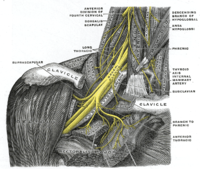
Photo from wikipedia
BACKGROUND Loss of motor function in the trapezius muscle is one complication of radical neck dissection after cutting the accessory nerve (AN) during surgery. Nerve repair is an effective method… Click to show full abstract
BACKGROUND Loss of motor function in the trapezius muscle is one complication of radical neck dissection after cutting the accessory nerve (AN) during surgery. Nerve repair is an effective method to restore trapezius muscle function, and includes neurolysis, direct suture, and nerve grafting. The suprascapular nerve (SCN) and AN are next to each other in position. The function of the AN and SCN in shoulder elevation and abduction movement is synergistic. SCN might be considered by surgeons for AN reanimation. AIM To obtain anatomical and clinical data for partial suprascapular nerve-to-AN transfer. METHODS Ten sides of cadavers perfused with formalin were obtained from the Department of Human Anatomy, Histology and Embryology, Peking University Health Science Center. The SCN (n = 10) and AN (n = 10) were carefully dissected in the posterior triangle of the neck, and the trapezius muscle was dissected to fully display the accessory nerve. The length of the SCN from the origin of the brachial plexus (a point) to the scapular notch (b point) and the distance of the SCN from the origin point (a point) to the point (c point) where the AN entered the border of the trapezius muscle were measured. The length and branches of the AN in the trapezius muscle were measured. A female patient aged 55 years underwent surgery for partial SCN to AN transfer at Department of Oral and Maxillofacial Surgery, Peking University School and Hospital of Stomatology. The patient suffered from recurrent upper gingival cancer. Radical neck dissection was performed on the right side, and the right AN was removed at the intersection between the nerve and the posterior border of the SCM muscle. One-third of the diameter of the SCN was cut off, and combined epineurial and perineurial sutures were applied between the distal end of the cut-off fascicles of the SCN and the proximal end of the AN without tension. Both subjective and objective evaluations were performed before, three months after, and nine months after surgery. For the subjective evaluation, the questionnaire included the Neck Dissection Impairment Index (NDII) and the Constant Shoulder Scale. Electromyography was used for the objective examination. Data were analyzed using t tests with SPSS 19.0 software to determine the relationship between the length of the SCN and the linear distance. A P value of < 0.05 was considered as statistically significant. RESULTS The whole length of the AN in the trapezius muscle was 16.89 cm. The average numbers of branches distributed in the descending, horizontal and ascending portions were 3.8, 2.6 and 2.2, respectively. The diameter of the AN was 1.94 mm at the anterior border of the trapezius. The length of the suprascapular nerve from the origin of the brachial plexus to the scapular notch was longer than the distance of the suprascapular nerve from the origin point to the point where the accessory nerve entered the upper edge of the trapezius muscle. The amplitude of trapezius muscle electromyography indicated that both the horizontal and ascending portions of the trapezius muscle on the right side had better function than the left side nine months after surgery. The results showed that the right-sided supraspinatus and infraspinatus muscles did not lose more function than the left side. CONCLUSION Based on anatomical data and clinical application, partial suprascapular nerve-to-AN transfer could be achieved and may improve innervation of the affected trapezius muscle after radical neck dissection.
Journal Title: World Journal of Clinical Cases
Year Published: 2022
Link to full text (if available)
Share on Social Media: Sign Up to like & get
recommendations!